Online Reports
Volume 26—2020
Volume 26, Number 12—December 2020
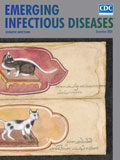
Role of Oral Rabies Vaccines in the Elimination of Dog-Mediated Human Rabies Deaths
Domestic dogs are responsible for nearly all the »59,000 global human rabies deaths that occur annually. Numerous control measures have been successful at eliminating dog-mediated human rabies deaths in upper-income countries, including dog population management, parenteral dog vaccination programs, access to human rabies vaccines, and education programs for bite prevention and wound treatment. Implementing these techniques in resource-poor settings can be challenging; perhaps the greatest challenge is maintaining adequate herd immunity in free-roaming dog populations. Oral rabies vaccines have been a cornerstone in rabies virus elimination from wildlife populations; however, oral vaccines have never been effectively used to control dog-mediated rabies. Here, we convey the perspectives of the World Organisation for Animal Health Rabies Reference Laboratory Directors, the World Organisation for Animal Health expert committee on dog rabies control, and World Health Organization regarding the role of oral vaccines for dogs. We also issue recommendations for overcoming hesitations to expedited field use of appropriate oral vaccines.
| EID | Wallace RM, Cliquet F, Fehlner-Gardiner C, Fooks AR, Sabeta CT, Setién A, et al. Role of Oral Rabies Vaccines in the Elimination of Dog-Mediated Human Rabies Deaths. Emerg Infect Dis. 2020;26(12):1-9. https://doi.org/10.3201/eid2612.201266 |
|---|---|
| AMA | Wallace RM, Cliquet F, Fehlner-Gardiner C, et al. Role of Oral Rabies Vaccines in the Elimination of Dog-Mediated Human Rabies Deaths. Emerging Infectious Diseases. 2020;26(12):1-9. doi:10.3201/eid2612.201266. |
| APA | Wallace, R. M., Cliquet, F., Fehlner-Gardiner, C., Fooks, A. R., Sabeta, C. T., Setién, A....Müller, T. (2020). Role of Oral Rabies Vaccines in the Elimination of Dog-Mediated Human Rabies Deaths. Emerging Infectious Diseases, 26(12), 1-9. https://doi.org/10.3201/eid2612.201266. |
Volume 26, Number 11—November 2020
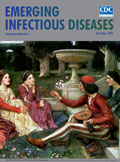
Early Insights from Statistical and Mathematical Modeling of Key Epidemiologic Parameters of COVID-19
We report key epidemiologic parameter estimates for coronavirus disease identified in peer-reviewed publications, preprint articles, and online reports. Range estimates for incubation period were 1.8–6.9 days, serial interval 4.0–7.5 days, and doubling time 2.3–7.4 days. The effective reproductive number varied widely, with reductions attributable to interventions. Case burden and infection fatality ratios increased with patient age. Implementation of combined interventions could reduce cases and delay epidemic peak up to 1 month. These parameters for transmission, disease severity, and intervention effectiveness are critical for guiding policy decisions. Estimates will likely change as new information becomes available.
Volume 26, Number 10—October 2020
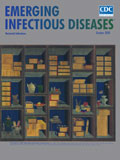
Effectiveness of Cloth Masks for Protection Against Severe Acute Respiratory Syndrome Coronavirus 2
Cloth masks have been used in healthcare and community settings to protect the wearer from respiratory infections. The use of cloth masks during the coronavirus disease (COVID-19) pandemic is under debate. The filtration effectiveness of cloth masks is generally lower than that of medical masks and respirators; however, cloth masks may provide some protection if well designed and used correctly. Multilayer cloth masks, designed to fit around the face and made of water-resistant fabric with a high number of threads and finer weave, may provide reasonable protection. Until a cloth mask design is proven to be equally effective as a medical or N95 mask, wearing cloth masks should not be mandated for healthcare workers. In community settings, however, cloth masks may be used to prevent community spread of infections by sick or asymptomatically infected persons, and the public should be educated about their correct use.
| EID | Chughtai AA, Seale H, Macintyre C. Effectiveness of Cloth Masks for Protection Against Severe Acute Respiratory Syndrome Coronavirus 2. Emerg Infect Dis. 2020;26(10):1-5. https://doi.org/10.3201/eid2610.200948 |
|---|---|
| AMA | Chughtai AA, Seale H, Macintyre C. Effectiveness of Cloth Masks for Protection Against Severe Acute Respiratory Syndrome Coronavirus 2. Emerging Infectious Diseases. 2020;26(10):1-5. doi:10.3201/eid2610.200948. |
| APA | Chughtai, A. A., Seale, H., & Macintyre, C. (2020). Effectiveness of Cloth Masks for Protection Against Severe Acute Respiratory Syndrome Coronavirus 2. Emerging Infectious Diseases, 26(10), 1-5. https://doi.org/10.3201/eid2610.200948. |
Enterovirus D68–Associated Acute Flaccid Myelitis, United States, 2020
Acute flaccid myelitis (AFM) is a serious neurologic condition that causes limb weakness or paralysis in previously healthy children. Since clusters of cases were first reported in 2014, nationwide surveillance has demonstrated sharp increases in AFM cases in the United States every 2 years, most occurring during late summer and early fall. Given this current biennial pattern, another peak AFM season is expected during fall 2020 in the United States. Scientific understanding of the etiology and the factors driving the biennial increases in AFM has advanced rapidly in the past few years, although areas of uncertainty remain. The Centers for Disease Control and Prevention and AFM partners are focused on answering key questions about AFM epidemiology and mechanisms of disease. This article summarizes the current understanding of AFM etiology and outlines priorities for surveillance and research as we prepare for a likely surge in cases in 2020.
| EID | Kidd S, Lopez AS, Konopka-Anstadt JL, Nix W, Routh JA, Oberste M. Enterovirus D68–Associated Acute Flaccid Myelitis, United States, 2020. Emerg Infect Dis. 2020;26(10):6-12. https://doi.org/10.3201/eid2610.201630 |
|---|---|
| AMA | Kidd S, Lopez AS, Konopka-Anstadt JL, et al. Enterovirus D68–Associated Acute Flaccid Myelitis, United States, 2020. Emerging Infectious Diseases. 2020;26(10):6-12. doi:10.3201/eid2610.201630. |
| APA | Kidd, S., Lopez, A. S., Konopka-Anstadt, J. L., Nix, W., Routh, J. A., & Oberste, M. (2020). Enterovirus D68–Associated Acute Flaccid Myelitis, United States, 2020. Emerging Infectious Diseases, 26(10), 6-12. https://doi.org/10.3201/eid2610.201630. |
Volume 26, Number 7—July 2020
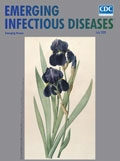
Evidence Supporting Transmission of Severe Acute Respiratory Syndrome Coronavirus 2 While Presymptomatic or Asymptomatic
Recent epidemiologic, virologic, and modeling reports support the possibility of severe acute respiratory syndrome coronavirus 2 (SARS-CoV-2) transmission from persons who are presymptomatic (SARS-CoV-2 detected before symptom onset) or asymptomatic (SARS-CoV-2 detected but symptoms never develop). SARS-CoV-2 transmission in the absence of symptoms reinforces the value of measures that prevent the spread of SARS-CoV-2 by infected persons who may not exhibit illness despite being infectious. Critical knowledge gaps include the relative incidence of asymptomatic and symptomatic SARS-CoV-2 infection, the public health interventions that prevent asymptomatic transmission, and the question of whether asymptomatic SARS-CoV-2 infection confers protective immunity.
Volume 26, Number 3—March 2020
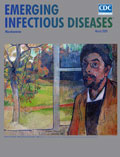
Improving Quality of Patient Data for Treatment of Multidrug- or Rifampin-Resistant Tuberculosis
International policy for treatment of multidrug- and rifampin-resistant tuberculosis (MDR/RR TB) relies largely on individual patient data (IPD) from observational studies of patients treated under routine conditions. We prepared guidance on which data to collect and what measures could improve consistency and utility for future evidence-based recommendations. We highlight critical stages in data collection at which improvements to uniformity, accuracy, and completeness could add value to IPD quality. Through a repetitive development process, we suggest essential patient- and treatment-related characteristics that should be collected by prospective contributors of observational IPD in MDR/RR TB.
Volume 26, Number 1—January 2020
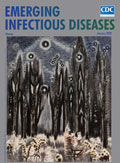
Plans for Nationwide Serosurveillance Network in Vietnam
In recent years, serosurveillance has gained momentum as a way of determining disease transmission and immunity in populations, particularly with respect to vaccine-preventable diseases. At the end of 2017, the Oxford University Clinical Research Unit and the National Institute of Hygiene and Epidemiology held a meeting in Vietnam with national policy makers, researchers, and international experts to discuss current seroepidemiologic projects in Vietnam and future needs and plans for nationwide serosurveillance. This report summarizes the meeting and the plans that were discussed to set up nationwide serosurveillance in Vietnam.
| EID | Anh D, Choisy M, Clapham HE, Cuong H, Dung V, Duong T, et al. Plans for Nationwide Serosurveillance Network in Vietnam. Emerg Infect Dis. 2020;26(1):1-6. https://doi.org/10.3201/eid2601.190641 |
|---|---|
| AMA | Anh D, Choisy M, Clapham HE, et al. Plans for Nationwide Serosurveillance Network in Vietnam. Emerging Infectious Diseases. 2020;26(1):1-6. doi:10.3201/eid2601.190641. |
| APA | Anh, D., Choisy, M., Clapham, H. E., Cuong, H., Dung, V., Duong, T....Rogier van Doorn, H. (2020). Plans for Nationwide Serosurveillance Network in Vietnam. Emerging Infectious Diseases, 26(1), 1-6. https://doi.org/10.3201/eid2601.190641. |




